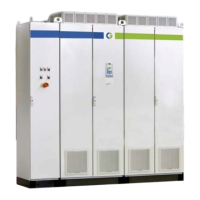148 Troubleshooting, Diagnoses and Maintenance CG Drives & Automation 01-7318-01r1
12.2 Trip conditions, causes and
remedial action
The table later on in this section must be seen as a basic aid
to find the cause of a system failure and to how to solve any
problems that arise. An AC drive is mostly just a small part
of a complete AC drive system. Sometimes it is difficult to
determine the cause of the failure, although the motor
inverter gives a certain trip message it is not always easy to
find the right cause of the failure. Good knowledge of the
complete drive system is therefore necessary. Contact your
supplier if you have any questions.
The AFR/AFG/VSI is designed in such a way that it tries to
avoid trips by limiting torque, overvolt etc.
Failures occurring during commissioning or shortly after
commissioning are most likely to be caused by incorrect
settings or even bad connections.
Failures or problems occurring after a reasonable period of
failure-free operation can be caused by changes in the system
or in its environment (e.g. wear).
Failures that occur regularly for no obvious reasons are
generally caused by Electro-Magnetic Interference. Be sure
that the installation fulfils the demands for installation
stipulated in the EMC directives. See chapter 8. page 51.
Sometimes the so-called “Trial and error” method is a
quicker way to determine the cause of the failure. This can
be done at any level, from changing settings and functions to
disconnecting single control cables or replacing entire drives.
The Trip Log can be useful for determining whether certain
trips occur at certain moments. The Trip Log also records
the time of the trip in relation to the run time counter.
12.2.1 Technically qualified personnel
Installation, commissioning, demounting, making
measurements, etc., of or at the motor inverter may only be
carried out by personnel technically qualified for the task.
12.2.2 Opening the FDUL/VFXR/
FDUG/VFXG
The connections for the control signals and the switches are
isolated from the mains voltage. Always take adequate
precautions before opening the AFR/AFG or VSI.
12.2.3 Precautions to take with a
connected motor
If work must be carried out on a connected motor or on the
driven machine, the mains voltage must always first be
disconnected from the AFR/AFG and VSI. Wait at least 5
minutes before continuing.
12.2.4 Autoreset Trip
If the maximum number of Trips during Autoreset has been
reached, the trip message hour counter is marked with an
“A”.
Fig. 94 Autoreset trip
Fig. 94 shows the 3rd trip memory menu [830]:
Overvoltage G trip after the maximum Autoreset attempts
took place after 345 hours, 45 minutes and 12 seconds of
run time.
WARNING!
If it is necessary to open the AFR/AFG or VSI
or any part of the system (motor cable
housing, conduits, electrical panels,
cabinets, etc.) to inspect or take measure-ments as
suggested in this instruction manual, it is absolutely
necessary to read and follow the safety instructions in
the manual.
WARNING!
Always switch the mains voltage off if it is
necessary to open the AFR/AFG or VSI and
wait at least 7 minutes to allow the
capacitors to discharge.
WARNING!
In case of malfunctioning always check the
DC-link voltage, or wait one hour after the
mains voltage has been switched off, before
dismantling the AFR/AFG or VSI for repair.
830 OVERVOLT G
Trp A 345:45:12

